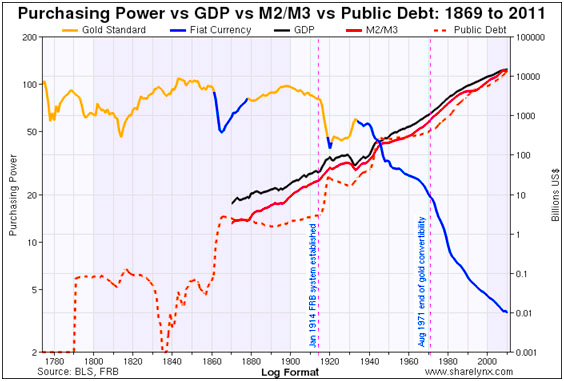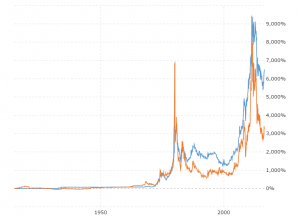What Is The Gold Standard?
Put simply, the Gold Standard is a monetary system where a country’s currency is based on a fixed quantity of gold. For example, a country could set the price of one ounce of gold at $100 dollars and gold would be bought and sold at that price. This would effectively give $1 dollar the value of 1/100th of an ounce of gold. Other precious metals could be used as a monetary standard – it was commonplace in the United States throughout the 1800’s to use both silver and gold, commonly referred to as bimetallism.
Throughout the 1800’s, the United States was informally on a bimetallic monetary system. However, gold was the mainly traded metal with silver accounting for only a small portion of trade. Because of such a skew, the U.S. was essentially on a gold standard. In 1900, the Gold Standard Act was passed and the United States was officially ushered into the Gold Standard. This lasted only 33 years, because in 1933, in the face of the Great Depression, President Franklin D. Roosevelt outlawed the private ownership of gold (with the exception of gold jewelry). Although the law was revoked, the U.S. still had its currency backed by gold reserves held in Fort Knox. The currency system existed in this fashion until in 1946 when The Bretton Woods System was enacted.
The Bretton Woods System’s original intent was to rebuild the international economic system which was still in shambles amidst World War II. 730 delegates from all 44 Allied nations met at the Mount Washington Hotel in Bretton Woods, New Hampshire to create a monetary system of fixed exchange rates that allowed governments to sell their gold to the United States at a price of $35 dollars per ounce. The Bretton Woods System was considered a success for the first few years following the end of World War II. Howevever, a negative balance of payments accrued, public debt swelled from the Vietnam War and Great Society programs and monetary inflation by the Federal Reserve reared its head. In 1971, Germany was unwilling to devalue its own currency so it left the Bretton Woods System. Following that move, their economy was strengthened. After Germany left the system, other countries began to redeem their dollars for gold with over $250 million in gold leaving the United States. This mass exodus of gold put pressure on the United States to leave the Bretton Woods System and ultimately the gold standard.
On August 15, 1971, President Richard Nixon announced the end of the Bretton Woods System by eliminating the trading of gold at a fixed price of $35 dollars per ounce. For the first time in history, formal links between major world currencies and physical commodities was severed. After the United States left the gold standard behind, every major economy in the world has followed. Currently, there are no major economies that follow the gold standard.
If We Don’t Use The Gold Standard, What Do We Use?
Almost every country in the world uses a system of fiat money. In a fiat money system, the money itself has no intrinsic value and is just used as a medium of exchange for goods and services. There is no amount of gold or silver that is “backing” the currency.
The Benefits Of A Gold Standard
One of the main benefits of the gold standard is its low level of inflation. Inflation is typically cause by one or a combination of the following four factors.
1. The supply of money increase.
2. The supply of goods decreases.
3. Demand for money increases.
4. Demand for goods increases.
As long as the supply of gold does not increase too sharply, then the supply of money will will stay relatively stable. Because a country’s money supply must be backed by gold, then there is no ability for that country to create more money – this prevents country’s from “printing more money.” For every dollar they create, they must back with an equal amount of gold. Since there is not an unlimited supply of gold, they cannot just print at will. By being on a gold standard, the Federal Reserve is prohibited from enacting policies that would significantly increase the growth of the money supply, which in turn limits the amount of inflation that can occur.
Another main benefit of the gold standard can be seen in the foreign exchange market. For example, if Japan is on the gold standard and has a set price of gold at $100 an ounce and Mexico is also on the gold standard with a set price of gold at 5,000 pesos per ounce, then 1 Japanese Yen must be worth 50 pesos. This fixed set of exchange rates creates stability and uniformity throughout all the countries that are on the standard. If all countries were to be on the gold standard, then there would be only one true currency, which would be gold. It is from gold which all other currencies would derive their value.
If it sounds too good to be true, it’s because it is. The gold standards biggest benefit (stability) is also its biggest drawback. Exchange rates of currencies are not allowed to respond to changing circumstances in countries. With the wild fluctuation of the geopolitical landscape these days, it is imperative that currencies have the flexibility to react with their circumstances. Because of this factor, countries that have gold standards typically exhibit severe economic shocks. Along with exchange rates being essentially locked, the gold standard impairs the government from using monetary policy to respond to economic and/or geopolitical crises.
As you can see, there are positive and negatives to the Gold Standard vs. Fiat Money, it appears that a change is not anywhere on the horizon. Although, there have been some high-profile businessmen that have been calling for a return to a modified gold standard, most notably Steve Forbes. Given the control and power that fiat money lends to those running it, it does not look like the gold standard will be returning to the United States in the foreseeable future.









